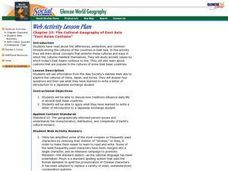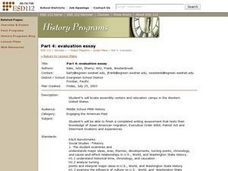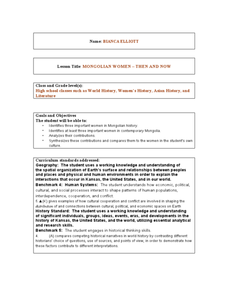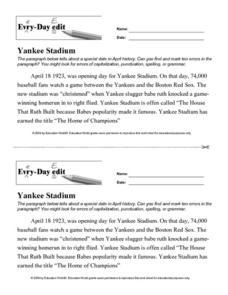Curated OER
Bird Watching
Students explore the implications of the avian flu. In this personal health activity, students listen to a lecture about the avian flu, its history, and how it spreads.
Curated OER
Immigration in the United States
Pupils examine the reasons why people leave their country to live in another. In groups, they use print and electronic resources to answer questions about where immigrants came from during different time periods and advice given to...
Curated OER
Human Settlement and Movement
Students are introduced to the way humans have settled and moved throughout history. In groups, they compare and contrast the settlement and movement of two different ethnic groups. They discover why some are more dominate in an area...
Curated OER
Creating a Self Portrait painting With Decorative Frame
Sixth graders view a large image of a painting and discuss the history and its role in past and current culture in Mexico. Student list the symbols portrayed in the work and explain their significance. Students use elements of art to...
Curated OER
Jackie Steals Home
Students read articles relating to Jackie Robinson's breaking of the racial barrier in professional baseball. This leads to a deeper exploration of racism in the United States. They use a variety of worksheets imbedded in this plan to...
Curated OER
Letters from the Japanese American Internment
Students examine letters of Japanese-American children during internment in World War II. They discover what it was like in the camps and how they were treated once they were released. They also view photographs of the camps.
PBS
Baker's Gold
Young scholars examine art of the California Gold Rush. In this visual arts lesson, students analyze the photography and art of Isaac Wallace Baker. Young scholars also conduct further research about the miners of the era in order to...
Curated OER
Lesson III: Crisis, Pearl Harbor, Internment
The third in a series of lessons introduced by “A Fence Away From Freedom,” uses the Smithsonian website, “A More Perfect Union: Japanese Americans and the U.S. Constitution” and focuses on the section of the presentation devoted to the...
Curated OER
Heroes
Students explore reading comprehension strategies. In this character development and reading comprehension lesson, students brainstorm common traits of "heroes." Students read Heroes, then identify the personal conflicts the story...
Curated OER
Chinese, Japanese, & Korean Immigration to the U. S.
Students study immigration of people from Southeast Asian countries to the United States. Pupils create maps and geographically illustrate the immigration. Using the internet, students research an assigned topic. They write an essay...
US National Archives
WWII: Asia 1939-45 – Singapore
The fall of Singapore in World War II was shocking news for the Allied forces—but why? High schoolers explore primary source documents and videos to determine why February 15, 1942 was a wake-up call to the British Empire and its allies...
Curated OER
The Cultural Geography of East Asia
Students use information from the Asia Society's AskAsia Web site to explore the cultures of China, Japan, and Korea. They answer four questions and then use what they have learned to write a letter of introduction to a Japanese exchange...
Curated OER
Wayang
Ninth graders discover the importance of the arts in Southeast Asia and relate it to their own lives and culture. They create and perform their own Shadow Play.
Curated OER
Ethnic Diversity
Young scholars explore the ethnic diversity of the British military. In this diversity lesson, students discuss the British West Indies Regiment rebellion and the reasons they believed it took place. Young scholars also study the...
Curated OER
China's Ethnic Minorities
Third graders are introduced to various Chinese ethnic groups. They consider how geography affects ethnic groups and examine artifacts produced by Chinese peoples. They prepare a presentation of their research and artifact interpretation.
Curated OER
The Imperial Republic: 1865-1914 (5)
In this online interactive social studies worksheet, students answer 14 matching questions regarding the Imperial Republic. Students may submit their answers to be scored.
Curated OER
Introduction to World Religions: Islam
Sixth graders explore religion by viewing a presentation in class. In this global culture lesson, 6th graders define the Islam religion and the stories that accompany it. Students read the story "Muhammad" by Demi and view an Internet...
Curated OER
Angkor What? Angkor Wat!
Tenth graders examine Angkor Wat and its place in history. They visit websites, utilize maps, and complete interactive worksheets. Students investigate the local temple to discover its purpose.
Curated OER
Evaluation Essay
Students write an essay about previous studied lessons that is applied to the Japanese American experience. They have to role play being a Caucasian, or Nisei in California at a given time based on what they have studied. What would...
Curated OER
Confucius: Words of Wisdom
Students view a documentary on Confucius. He is revered as one of the greatest teachers in history. Confucius' name is synonymous with ageless wisdom. After viewing, students discuss what they saw then complete writing and art activities...
Curated OER
MONGOLIAN WOMEN - THEN AND NOW
Students are introduced to the history of Mongolia. This is a general overview before going into the real detail of the lesson. The main focus is upon the development of the women of Mongolia and the major contributions they have made.
Education World
Every Day Edit - Yankee Stadium
In this everyday editing learning exercise, students correct grammatical mistakes in a short paragraph about Yankee Stadium. The errors range from punctuation, capitalization, grammar, and spelling.
Education World
Every-Day Edit: Alexander Graham Bell
In this everyday editing instructional activity, learners correct grammatical mistakes in a short paragraph about Alexander Graham Bell. The 10 errors range from capitalization, punctuation, spelling, and grammar.
Education World
Every-Day Edit: Leap Second
In this everyday editing instructional activity, the grammatical errors include capitalization, punctuation, spelling, and grammar. Learners correct these grammatical mistakes in a short paragraph about Leap Second.
Other popular searches
- Asian History Month
- Ancient Asian History
- Asian History Lesson Plans
- Asian History China
- Asian History Kinesthetic
- Asian History India
- Modern Asian History
- Central Asian History
- Asian History Anesthetic
- Asian History Intro
- East Asian History Month
- Asian American History Poems

























